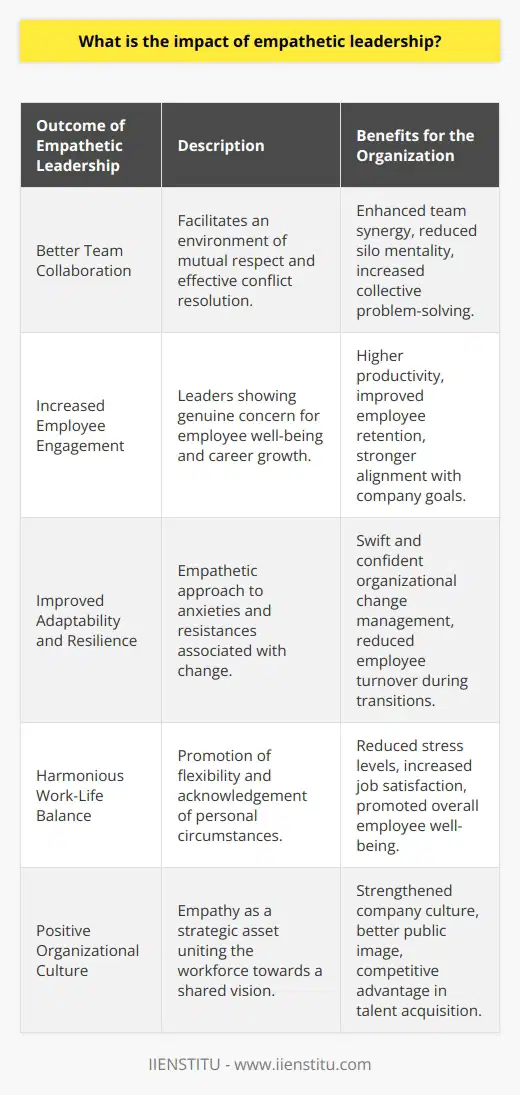
This article explored the impact of decisions on customers, internal customers, and external stakeholders and how to lead with empathy to ensure that all parties are considered. Engaging with customers and internal customers is essential to understand their needs and requirements and to consider the needs of external stakeholders when making decisions. Leading with empathy involves considering the potential impact of decisions on all parties and taking steps to minimize any negative impact.
Introduction
Impacted Customers
Internal Customers
External Stakeholders
Leading with Empathy
Introduction: When making decisions about product features, design, performance, pricing, and other aspects, it is essential to consider the impact these decisions will have on customers. While there is a wealth of literature on how to engage with customers, discover their needs, and validate solutions, there is often a need to consider the impact of decisions on internal customers and external stakeholders. In this article, we will explore the impact of decisions on customers, internal customers, and external stakeholders and how to lead with empathy to ensure that all parties are considered.
Impacted Customers
Customers are affected by your decisions about features, design, performance, pricing, etc. Customers may have specific needs and requirements to consider when making decisions. Engaging with customers and understanding their needs and requirements is essential to ensure that decisions are made with their best interests in mind. This may involve conducting customer surveys, interviews, focus groups, or other methods of gathering customer feedback.
Internal Customers
In addition to external customers, it is also essential to consider the impact of decisions on internal customers. Internal customers are those within the organization who use the product or service being developed. These customers may include sales and support, training, HR, and finance teams. It is essential to consider the needs of these teams when making decisions to ensure that they can effectively use the product or service. For example, the sales and support teams may need the product to be easy to sell and service, and the training team may need lead time to develop new material for product enhancements.
External Stakeholders
It is also essential to consider the impact of decisions on external stakeholders. These stakeholders may include investors, partners, vendors, regulators, and other parties interested in the product or service. It is essential to consider the needs of these stakeholders when making decisions to ensure that their interests are considered. For example, investors may need to be informed of changes to make informed decisions about investing in the product or service.
Leading with Empathy
When making decisions, it is essential to lead with empathy. This means considering the needs and interests of all parties involved, including customers, internal customers, and external stakeholders. It is essential to engage with all parties to understand their needs and requirements and to ensure that decisions are made with their best interests in mind. Leading with empathy also involves considering the potential impact of decisions on all parties and taking steps to minimize any negative impact.
Conclusion: When making decisions about product features, design, performance, pricing, and other aspects of a product, it is essential to consider the impact these decisions will have on customers, internal customers, and external stakeholders. It is essential to engage with all parties to understand their needs and requirements and to ensure that decisions are made with their best interests in mind. Leading with empathy will help to ensure that all parties are taken into consideration and that any potential negative impacts are minimized.
Leading with empathy creates a ripple effect of positive impacts on customers and stakeholders alike.
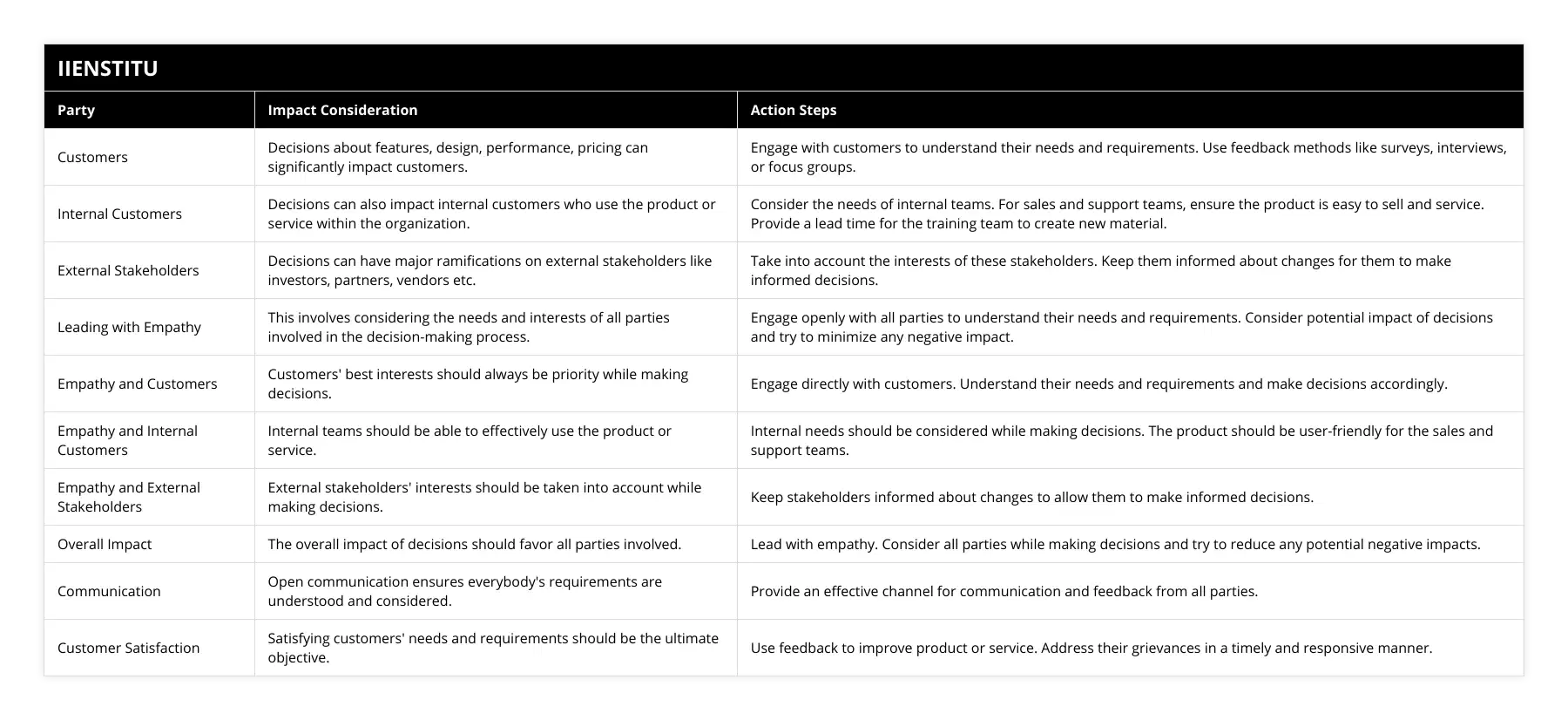
Frequently Asked Questions
What are the benefits of leading with empathy when impacting customers and stakeholders?
Leading with empathy is a powerful tool that can be used to impact customers and stakeholders in a business positively. Empathy involves developing a deeper understanding of the needs and feelings of others. It is a way to connect with customers and stakeholders on an emotional level and build strong relationships. When leaders lead with empathy, they can better understand the needs of their customers and stakeholders and create strategies that meet those needs.
Empathy leads to increased customer loyalty. When customers feel that their needs and feelings are understood, they are more likely to remain loyal to the brand. Additionally, leading with empathy can lead to improved customer service. Customers are more likely to have a positive experience when leaders demonstrate empathy and understanding. As a result, customer satisfaction can be improved, and customer loyalty can increase.
Leading with empathy can also lead to improved collaboration between customers and stakeholders. Empathy can help create an environment of trust and understanding, enabling customers and stakeholders to work together more effectively. Furthermore, leading with empathy can help to drive innovation. When leaders take the time to understand the needs and feelings of their customers and stakeholders, they can better create innovative solutions to meet their needs.
Additionally, leading with empathy can help to create a more productive work environment. Research has shown that employees feel more valued and respected when leaders demonstrate empathy and understanding. As a result, morale can be improved, and employees can be more productive.
Overall, leading with empathy can be a powerful tool for positively impacting customers and stakeholders. It can lead to increased customer loyalty, customer service, collaboration, and innovation. It can also help to create a more productive work environment. For these reasons, empathy should be essential to any leader’s toolkit.

How can leaders ensure their tone of voice is empathetic when communicating with customers and stakeholders?
How leaders communicate with customers and stakeholders is of paramount importance. An effective leader must be able to communicate their message in a respectful and empathetic manner. This article explores best practices for leaders to ensure their tone of voice is empathetic when communicating with customers and stakeholders.
The first step for leaders to ensure their tone of voice is empathetic is to be mindful of the language they use. Leaders should ensure that the words they use reflect their understanding of the customer or stakeholder’s situation and avoid using dismissive or condescending language. Leaders should also strive to use language that conveys understanding and respect.
The second step is for leaders to be aware of the non-verbal cues they are sending. Non-verbal communication, such as body language, facial expressions, and gestures, can significantly impact how the customer or stakeholder perceives the leader’s message. Leaders should ensure that their non-verbal cues reflect their understanding of the customer or stakeholder’s situation and that they are sending positive messages.
The third step for leaders to ensure their tone of voice is empathetic is to be aware of their listening skills. Listening is essential to effective communication, and leaders should strive to listen actively and attentively to the customer or stakeholder. This includes paying attention to the customer or stakeholder’s body language and verbal cues. Leaders should also make sure to avoid interrupting the customer or stakeholder and to ask questions to gain a better understanding of their perspective.
Finally, leaders should strive to be patient and open-minded when communicating with customers and stakeholders. This means being open to different ideas and perspectives and being willing to listen and learn from others. Furthermore, leaders should be willing to take the time to explain their ideas and be open to feedback from customers and stakeholders.
In conclusion, influential leaders must be mindful of their language and the non-verbal cues they send to ensure their tone of voice is empathetic when communicating with customers and stakeholders. Leaders should also strive to be active listeners and be patient and open-minded to create an atmosphere of understanding and respect. By following these best practices, leaders can ensure that their tone of voice is empathetic and that their message is conveyed in a manner that is respectful and effective.
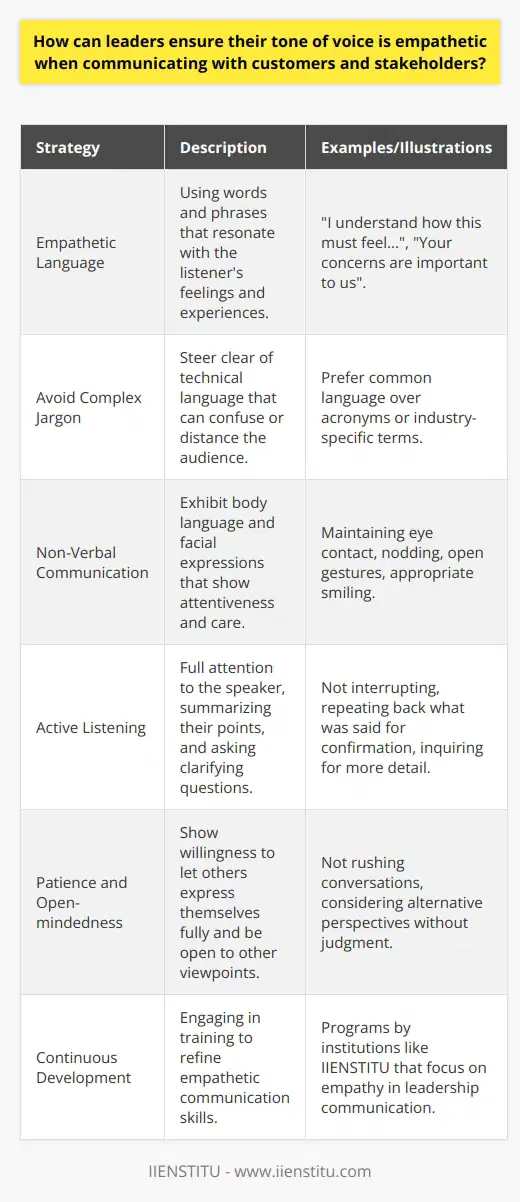
What strategies can be used to foster empathy in customer and stakeholder relationships?
In an increasingly competitive and interconnected world, customer and stakeholder relationships are increasingly important for companies to succeed. As such, fostering empathy in customer and stakeholder relationships is essential for businesses to ensure long-term success. This article will discuss strategies that can be used to foster empathy in customer and stakeholder relationships.
The first strategy that can be used to foster empathy in customer and stakeholder relationships is to create a customer-centric culture. This means creating an environment where customer feedback is valued and considered in decision-making. It also means actively listening to customer feedback and responding promptly. Additionally, providing consistent customer service, addressing customer complaints and issues, and consistently providing value to customers are all critical components of a customer-centric culture.
The second strategy that can be used to foster empathy in customer and stakeholder relationships is to cultivate relationships with stakeholders. Stakeholder relationships can be cultivated by proactively communicating, providing transparency, and building trust with stakeholders. Additionally, providing value to stakeholders and engaging in regular communication are effective ways to build strong relationships with stakeholders.
The third strategy to foster empathy in customer and stakeholder relationships is to focus on customer experience. This means understanding the customer journey, their needs, and how to meet them best. Additionally, providing quality products and services, delivering on customer expectations, and providing a consistent customer experience are all essential components of customer experience.
Finally, the fourth strategy to foster empathy in customer and stakeholder relationships is to focus on diversity and inclusion. This means understanding the needs of different customer segments and creating an environment where all customers feel welcome and valued. Additionally, creating a workplace where diversity is embraced and celebrated fosters empathy in customer and stakeholder relationships.
In summary, several strategies can be used to foster empathy in customer and stakeholder relationships. These strategies include creating a customer-centric culture, cultivating relationships with stakeholders, focusing on customer experience, and diversity and inclusion. By implementing these strategies, businesses can ensure that customer and stakeholder relationships are long-lasting.
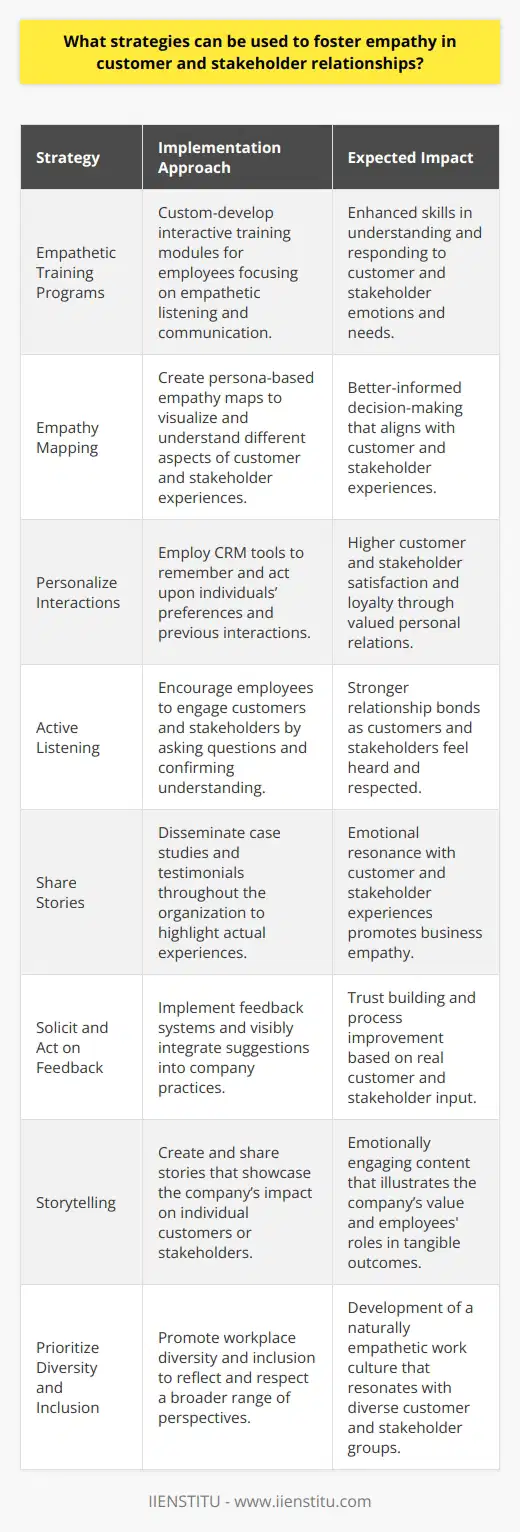
What is the benefit of using empathy to influence stakeholders?
Enhanced Understanding of Stakeholder Perspectives
Utilizing empathy has numerous benefits when trying to influence stakeholders. Primarily, it facilitates a deeper understanding of their perspectives and concerns. With empathy, you can better anticipate their responses, concerns, or objections, allowing for a more targeted and resonant communication approach.
Building Trust with Stakeholders
Secondly, displaying empathy develops trust between the organization and its stakeholders. Trust is a critical factor in influencing stakeholders' attitudes and behaviors. If they sense you genuinely understand and consider their viewpoints, they are more likely to trust your decisions and initiatives.
Improved Decision-Making
Furthermore, integrating empathy into decision-making processes can enhance the quality of the decisions made. Through empathy, leaders can perceive the potential impact of their decisions on different stakeholders, thus enabling them to make balanced and fair choices that take into account various stakeholder interests.
Enhanced Collaboration
Lastly, empathy can enhance collaboration between the organization and its stakeholders. Understanding stakeholders' needs and concerns can foster a collaborative spirit, encouraging mutual problem-solving and cooperation. This engagement can lead to shared goals, enhancing the synergy between stakeholders and the organization.
In conclusion, the benefits of using empathy to influence stakeholders range from gaining a deeper understanding of their views to facilitating collaboration and trust-building. It enables a more effective decision-making process, which considers the diverse interests of stakeholders. Consequently, empathy should be a critical element in any stakeholder engagement strategy.
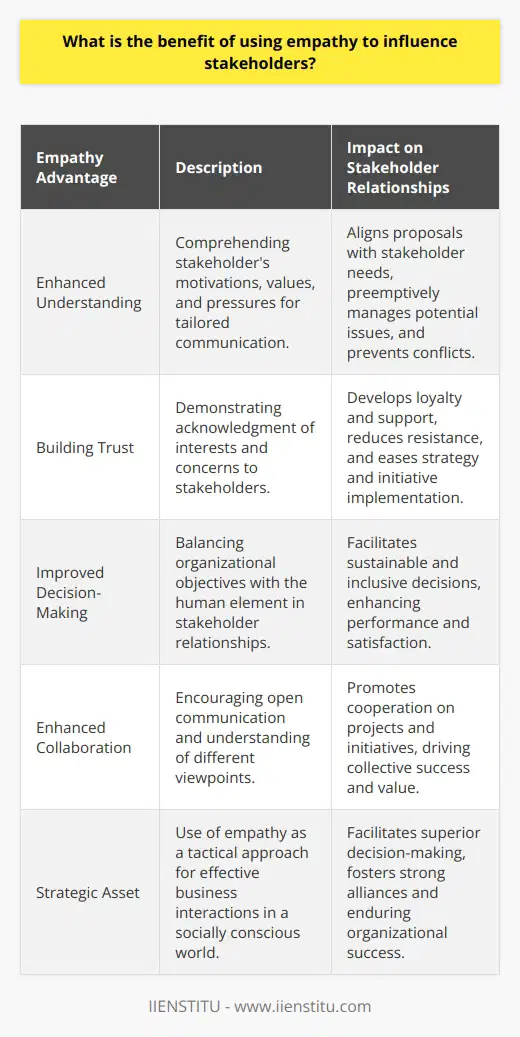
How does empathy impact customer service?
Understanding Empathy's Role
Empathy plays a significant role in customer service by allowing an individual to understand the customer's perspective. It involves feeling what the customer feels and addressing their needs and concerns appropriately.
Effects of Empathy on Customer Experience
Acting empathetically fosters a positive customer experience. It shows customers that their feelings are valid and important. This results in higher customer satisfaction, building trust in the brand.
Influence on Problem-Solving
Empathy helps service providers to solve problems more effectively. Understanding a customer's emotions helps identify their needs, enabling an efficient and satisfying resolution. This leads to an improved customer-company relationship.
Implication on Customer Loyalty
The application of empathy in customer service can lead to increased customer loyalty. Customers appreciate being understood and tend to stick with brands that make them feel seen and valued.
Impact on Communication
Lastly, empathy greatly impacts communication, promoting effective dialogue between the customer and service provider. It ensures the generation of responses that resonate with the customer, enhancing understanding and resolution of their issues.
Overall, empathy significantly shapes customer service. By promoting understanding, effective problem-solving, and good communication, it enhances customer satisfaction and loyalty.

What is the impact of empathetic leadership?
The Positive Influence of Empathetic Leadership
Empathetic leadership significantly impacts the workplace environment. This style of leadership helps foster stronger interpersonal relationships, critical to team dynamics. Through empathy, leaders understand and acknowledge employees' feelings, concerns, and perspectives, promoting trust and open communication.
Boosting Employee Morale
When leaders display empathy, it contributes to high morale and a positive workplace culture. They effectively respond to employees' emotions, making them feel valued and understood. Thus, empathy helps in reducing stress and burnout, leading to increased job satisfaction and productivity.
Strengthening Loyalty and Retention
Empathetic leadership has a positive impact on loyalty and retention. Employees are more likely to remain loyal to a company if they feel respected and heard. By understanding and responding to employees' needs, empathetic leaders encourage loyalty, effectively reducing turnover rates.
Enhancing Creativity
Empathy yields creativity within a team. By empathizing with the team, leaders cultivate an environment where everyone's opinions and ideas matter. This inclusive involvement fosters innovation, allowing the company to remain competitive.
Promoting Ethical Behavior
Empathy also influences ethical behavior. Empathetic leaders promote fairness, respect, and equality, encouraging ethical behavior within the company. With empathetic guidance, businesses can maintain a good reputation.
In conclusion, empathetic leadership positively impacts many crucial aspects of a business. From boosting morale and creativity to inspiring loyalty and enforcing ethical behavior, empathy plays a pivotal role in fostering a thriving workplace culture. Therefore, for successful management, leaders must understand and incorporate empathy in their leadership style.
